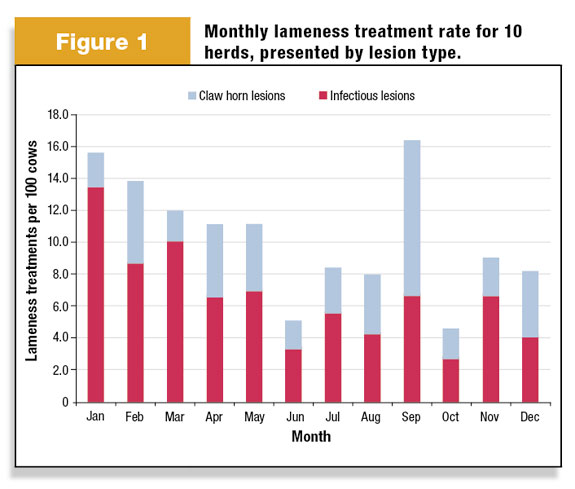For many dairy farmers, 2009 was a difficult winter in many parts of the country. Snow in December, along with additional storms and extreme cold temperatures, left dairy farmers numerous obstacles to deal with. One of those obstacles is hoof care and lameness. All too often lameness is an underlying issue robbing dairy farmers of profits. It is estimated that every lame cow on a dairy farm costs between $300 and $400 due to lost production, decreased reproductive efficiency and cost of treatment. Research by Dr. Nigel Cook at the University of Wisconsin – Madison showed that January, February and March are the months where lameness caused by infectious lesions is most prevalent (Figure 1). Dr. Cook tracked lameness in ten Wisconsin dairy herds for a 12-month period.

Causes of infectious lameness include heel warts, foot rot, corns, and heel erosion, with the most common being heel warts. Infectious lameness is caused by viral or bacterial agents. Claw horn lesions are another form of lameness, commonly caused by environmental conditions that lead to hoof injuries such as white line disease and ulcers.
Throughout a large portion of the year, infectious causes of lameness are commonly managed with routine cleaning of facilities as well as the use of well-managed footbaths. Regular trimming, use of dietary additives, and proper nutrition represent other management techniques used by dairy producers to control lameness.
Winter weather conditions often lead to the following:
• Decreased foot bathing
• Slippery walking surfaces
• Rigid walking surfaces
Another factor to consider is that frozen conditions experienced in dairy facilities leads to dry cracked skin around cows’ hooves. This, combined with the conditions described above, give rise to lameness caused by infectious agents.
Here are some recommendations for overcoming winter lameness:
1. Review your use of footbaths during the winter months.
• Consider using portable footbaths.
• Remember that formalin solutions lose their effectiveness below 45° Fahrenheit. So use of an alternative product is necessary in winter months. Position footbaths close to the parlor or in warmer areas to avoid frozen solutions.
2. In freezing and harsh conditions, routine scraping becomes even more important. Rather than decreasing the cleaning schedule, it is vital to maintain or increase efforts during freezing conditions in order to avoid uneven, rigid walking surfaces. Having protocols in place and discussions in advance with employees to enforce this may be necessary.
3. In smaller herds or groups, a dry footbath may be a viable alternative. These should consist of hydrated lime with an inclusion of 5% copper sulfate. Dry footbaths work best when feet are fairly clean and need to be deep enough for the lime to get between the claws where infections begin.
4. Additional efforts to keep feet clean, such as spraying feet in the parlor, can help. This is even more important on days where footbaths are being used, as it keeps the footbath cleaner, which improves the effectiveness of the footbath. Use of topical solutions in the parlor also provides another way to treat cows with infectious lameness, and it can serve as a preventative as well.
5. Other areas such as return alleys and icy waterers can be potential hazards as well. So preventative maintenance on waterers as well as increased or more thorough scraping of these areas is necessary in winter months.
6. Claw horn lesions such as ulcers are often a result of increased time spent standing. Improperly maintained stalls can easily lead to this. To avoid this, make sure that sand stalls are filled and raked routinely. Ensure mattresses have adequate bedding to promote good stall usage.
7. Maintain a regular trimming schedule during the winter months. Considering that each case of lameness cost approximately $400 and that a hoof trimmer may charge up to $20 per cow, dairy producers can perform 20 maintenance trims for every one case of clinical lameness.
8. Given the recent dairy economy, producers may have made the decision to remove some vitamins and minerals from rations to save on cost. Now may be a good time to place them back into rations in order to improve foot health.
While all of these suggestions may not be applicable on every dairy, it is important to be aware of the costs associated with lameness and to make sound management decisions to best minimize those costs and maximize profitability. PD
References omitted due to space but are available upon request to editor@progressivedairy.com.
— Excerpts from Dairy Tech-Line Newsletter, February 2010
Dan Schimek
Ruminant Nutritionist
Hubbard Feeds
dan.schimek@hubbardfeeds.com





